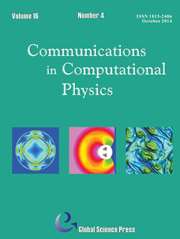Article contents
A High-Order Time Domain Discontinuous Galerkin Method with Orthogonal Tetrahedral Basis for Electromagnetic Simulations in 3-D Heterogeneous Conductive Media
Published online by Cambridge University Press: 08 March 2017
Abstract
We present a high-order discontinuous Galerkin (DG) method for the time domain Maxwell's equations in three-dimensional heterogeneous media. New hierarchical orthonormal basis functions on unstructured tetrahedral meshes are used for spatial discretization while Runge-Kutta methods for time discretization. A uniaxial perfectly matched layer (UPML) is employed to terminate the computational domain. Exponential convergence with respect to the order of the basis functions is observed and large parallel speedup is obtained for a plane-wave scattering model. The rapid decay of the out-going wave in the UPML is shown in a dipole radiation simulation. Moreover, the low frequency electromagnetic fields excited by a horizontal electric dipole (HED) and a vertical magnetic dipole (VMD) over a layered conductive half-space and a high frequency ground penetrating radar (GPR) detection for an underground structure are investigated, showing the high accuracy and broadband simulation capability of the proposed method.
Keywords
- Type
- Research Article
- Information
- Copyright
- Copyright © Global-Science Press 2017
References
- 3
- Cited by




